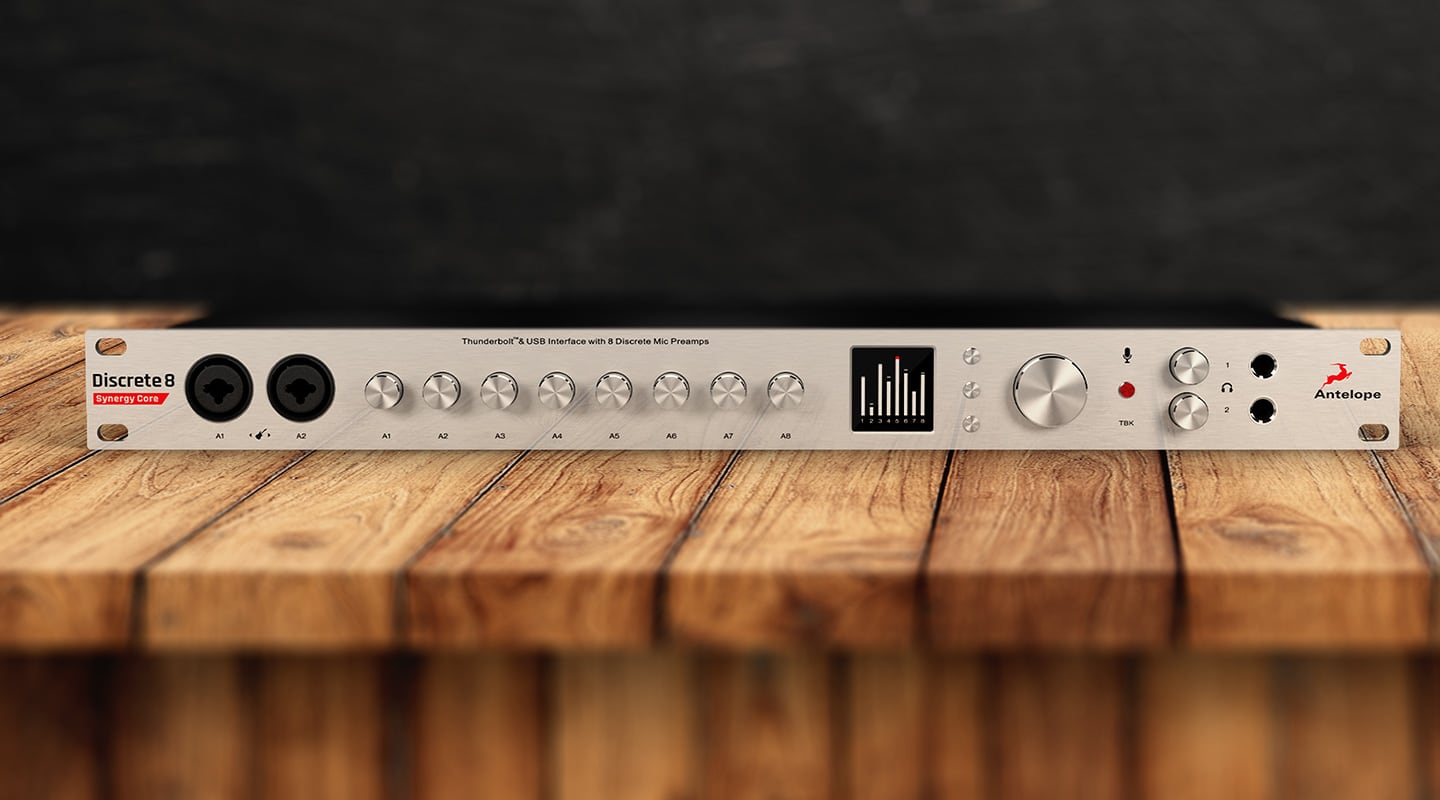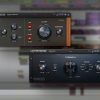
Review: Antelope Audio Discrete 8
Antelope takes interface processing to new heights by ‘synergising’ DSP and FPGA in the one box.
I remember the day my Antelope Audio Zen Tour desktop interface arrived in a parcel and I rushed home to set it up in my small studio setup. Hearing audio for the first time through the Zen Tour’s pristine conversion was a revelatory moment, for me — like a blanket was lifted from my studio monitors and I was finally listening to the real thing. I’m a believer in the Antelope difference.
Besides the impeccable conversion, another Antelope selling point is its use of built-in FPGA processing chips. Interfaces such as the Zen Tour, Orion Studio and Goliath HD all possess internal processing power to run Antelope plug-ins in real-time thanks to these powerful chips.
Now with a new family called Synergy Core, Antelope is exploring the world of DSP. Unlike FPGA chips, digital signal processors are a form of microprocessor which excel in handling larger amounts of processing in real-time — think: UAD interface systems.
We received the Synergy Core Discrete 8 interface for review. Two DSP chips within can run up to 64 instances of effects, at any sample rate; to give a stated “eight times the processing power of the Discrete Basic”. FPGA technology still makes an appearance — hence the ‘Synergy’ title. Capitalising on the strengths of both processing types, the single FPGA chip takes care of internal I/O routing and recreation of studio effects and mic models for use with Antelope’s Edge and Verge modelling microphones.
The Discrete 8 Synergy Core offers both USB and Thunderbolt connectivity (including Thunderbolt for Windows) and includes eight built-in, digitally-controlled transistor preamps. Key information is displayed on a screen along with a row of eight detented gain knobs, two mic/line/instrument inputs, two headphone outputs and a pushable control knob. You also get two ADAT inputs/outputs, two reamp outputs, eight DC-coupled line outputs via DB25, and SPDIF in and out. Considering the numerous I/O options, DSP power and high end specs, the Discrete 8 Synergy Core is a formidable beast for a 1U interface.
GRUNT WORK: BOOT CAMP
Despite all that power under the bonnet, trying to boot the thing up wasn’t straighforward. I followed the instructions on Antelope’s website to start the Launcher app which automatically detected the connected Discrete 8 Synergy Core. After picking the latest firmware version and clicking update, the Launcher kept stalling at a certain point, freezing up the GUI on both the application and the interface’s screen. I tried all the usual troubleshooting hacks to no avail. After six attempts I took up my case with Antelope.
After going back and forth with tech support, the only way I could update the firmware was by running the Launcher on another computer — and only then did the interface leave its frozen lock-out mode and accept the firmware update.
Unfortunately, this kind of drama isn’t unheard of with Antelope products. I had a similar experience with my Zen Tour. Clearly, it’s something Antelope needs to address.
NEED TO KNOW

RECORDING: 888
Once the Discrete 8 was firing, my first proper hitout was at a local performing arts centre for a large live recording session. The full band lineup called for no less than 24 inputs, so I supplemented the eight built-in pres with another two eight-channel preamps via the dual ADAT inputs. A baptism of fire, to be sure, however, its performance contributed to the resounding success of the session.
A well-considered routing program makes a huge difference when handling 24 inputs. The Antelope software is very functional with an easy-to-read GUI and cleaner layout than the version that comes with my Zen Tour. Gains for the eight onboard preamps can be set along the top section while levels for a few separate mixes are set with the faders in the middle section. Whipping up a couple of monitor mixes was easy. A little switch icon toggles between displaying the built-in eight or full 32 channels of I/O.
DSP + FPGA
The real story behind a Synergy Core product is the processing and effects. The Discrete 8 includes 36 DSP-powered effects (54 plus AFX2DAW with the introductory offer). These are available across the eight built-in preamps. You can build virtual channel strips within the control panel software in the row marked ‘AFX’, or select from a list of presets. As the name suggests, the AFX2DAW plug-in allows you to run Antelope’s FPGA software as inserts within your DAW session without burdening your computer’s CPU.
Clicking in the AFX box of a track opens a separate window in which the actual channel strip can be configured (fancy GUI and all). An at-a-glance view is provided in the main window showing the chain of effects on each track, along with a BP switch to bypass all processing.
The effects menu leaves little to be desired. I can’t get enough of the old-school models under Vintage EQs, Vintage Compressors and Vintage Preamps. All possess a distinct and usable character that’s convincingly analogue. More utilitarian tools are available too, like a parametric EQ and noise gate.
In the tracking room, Antelope’s DSP effects are nothing short of stunning. I put a couple of the vintage compressors and preamps to task on a basic acoustic guitar and vocal tune. The result was similar to taking a 2D photo and putting it through a lenticular lens, imbuing it with a sense of depth and three-dimensionality. In fact, it contributed so much warmth and richness to my recordings that I sorely missed it when bypassed.
One of my favourite features of the Zen Tour is AuraVerb, Antelope’s ‘comfort’ reverb, which also runs off internal DSP grunt. AuraVerb is on tap for all 32 inputs of the Synergy Core Discrete 8. Access it by clicking the AuraVerb logo at the bottom right of the control panel, then adjusting individual send amounts. Tonally the reverb can be tweaked to your liking with plenty of flexibility (Colour, Predelay, Early and Late Reflections Gain controls, Richness, Reverb Time and Room Size). A touch of reverb in headphones while tracking is a sure way to please a vocalist.
RUN DSP
The promise of mass DSP power is why most people, myself included, will be interested in Antelope’s Synergy Core products. In real world scenarios it means you’re putting better-sounding tracks to tape because they’re running through high quality emulations of vintage gear, all of which is supplied to the artist with zero latency. In I/O and horsepower terms, you won’t find another system for the same price — a UAD system, Antelope’s direct competition, will set you back significantly more money.
Of course, none of that power would matter if the effects were second class — and they’re not. I would be happy to track all my sessions through these plug-ins. They’re that good.
I really wish my experience in launching the device wasn’t quite so painful, otherwise I’d have absolutely no hesitancy in totally recommending the Discrete 8 Synergy Core. But a little like childbirth (so I’m told), the birth pangs are soon forgotten once you’re using the interface and enjoying its power and sound. With this amount of power on tap, it represents massive value, and as long as Antelope commits to ironing out the wrinkles in its hardware/software integration, this rig demands consideration.

























RESPONSES